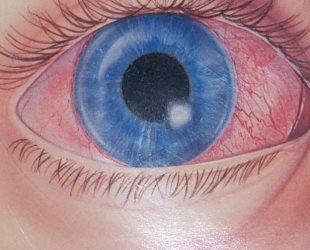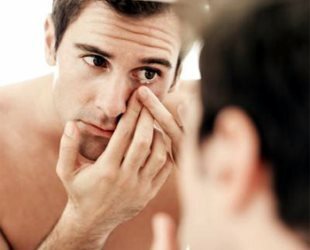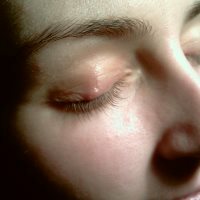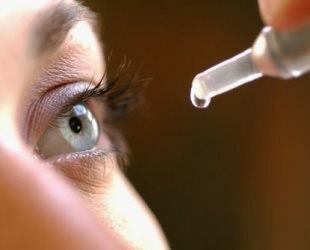
One of the dangerous eye diseases is keratitis - it is an inflammatory disease of the cornea of the eye.
It can be of a different nature, in which the cornea becomes cloudy, leading to visual impairment until complete blindness.
The nature of the course of the disease and the severity of the effects of keratitis depends on the overall immunity of the patient.
In this article, we will analyze the symptoms and ways of treating this disease.
- 1. What can be keratitis?
- 2. The reasons for the appearance of
- 3. The main symptoms of the disease
- 4. Diagnosis
- 5. Treatment
- 6. Prevention of the disease
What can be keratitis?
Inflammation of the cornea of the eye can have several types and types. Types of keratitis are divided into surface ( as a result of complications after conjunctivitis, for example) and deep , in which the cornea inflames and scars can form.
Types of keratitis:
- Infectious keratitis( viral, bacterial, fungal).
- Photokeratitis.
- Ulcerative keratitis.
- Onchocerciasis keratitis.
- Spring keratoconjunctivitis.
Any of these types of keratitis can be both superficial and deep.
Infectious keratitis
This species is subdivided in turn into bacterial, viral, fungal. The causes of bacterial keratitis can be exogenous and endogenous. Exogenous refers to:
- injury;
- burn;
- surgical intervention,
- ingestion of foreign matter,
- permanent wearing of contact lenses;
- improper storage of contact lenses.
Endogenous include:
- eye pathology;
- diabetes;
- focal chronic infections;
- weakened immunity;
But the most common causes of bacterial keratitis are staphylococci, pneumococci, streptococci and Pseudomonas aeruginosa.
The disease manifests itself immediately and very actively. There is a tear and strong carvings in the eye, the cornea becomes dull. From the eye mucus begins to secrete with pus. With the defeat of the cornea, the surface and deep vessels expand, tissue seals of pink and yellow color of various sizes appear, the surface of the cornea becomes covered with ulcers, and vision rapidly deteriorates.
If the bacterial keratitis is not treated in time, the disease leads to blindness.
Viral keratitis
One of the most common causes of this type is herpes. If this disease is caused by the disease, then viral keratitis is also called herpetic. The virus will manifest itself under the influence of the following factors:
- decreased immunity;
- stress;
- influenza and SARS;
- subcooling;
- trauma to the eye;
- vaccination.
That is, any condition in which the integrity of the cornea of the eye is impaired. To diseases leading to such a condition, except for herpes, measles, chicken pox are considered.
Symptoms often appear against the background of a cold. There is lacrimation and photophobia, corneal turbidity occurs. The vessels dilate and there is a severe pain in the eye. There is a decrease in visual acuity. Herpetic keratitis is also manifested as small ulcers on the lips, wings of the nose.
On the variants of its clinical picture of viral keratitis can be: discoid, tree-like, point, vesicle. Viral hepatitis is prone to frequent relapses.
Fungal keratitis is caused by fungal pathogens and proceeds in the same way as bacterial.
Photokeratitis
Photokeratitis occurs as a result of trauma to the cornea of the eye by ultraviolet radiation. In other words, this disease arises from the burn of the eye. It can be:
- with prolonged exposure to the sun without protective glasses;
- when welding without a protective mask;
- due to the action of laser beams( pointer, light shows)
Photokeratitis is manifested by pain in the eyes, lacrimation, redness of the eye, fear of light, corneal edema and mucous membrane, sensation of sand in the eye. Vision with the development of symptoms may not be disturbed, but there is constant pain. If you are at rest, the cornea of the eye returns to normal within a few days.
Ulcerative keratitis affects mostly residents of developing countries. The lack of vitamin affects the entire body, including the cornea of the eye. Often, ulcerative lesions can lead to blindness.
Spring keratoconjunctivitis
This disease, mainly affecting males, from the age of five and passing to the period of puberty. Often in childhood, concomitant diseases are asthma and eczema.
This kind of keratitis can occur both seasonally and year-round. It is accompanied by eye itching, tearing, photophobia, burning in the eye, mucous discharge appears. All the symptoms intensify toward evening.
The causes of the disease were not fully clarified, it was noted that year-round flow is observed in patients with bronchial asthma, vasomotor rhinitis, food and drug allergy.
Onchocerciasis keratitis
Onchocerciasis is a disease in which a helminth enters the human eye, causing inflammation of the cornea and other numerous complications that can lead to loss of vision. The carriers of helminths are midges, which are found along the banks of rivers.
Onchocerciasis keratitis is characterized by chronic conjunctivitis. If a person is infected a long time for several years, then the conjunctiva becomes yellowish and thickens. There is lacrimation of photophobia and itching of the eyelids.
There are several subspecies of onchocerciasis keratitis, it is a sclerosing with several stages and a spot. Sclerosing keratitis is a frequent cause of blindness in the peoples of central Africa.
Causes of the appearance of
Sometimes when diagnosing keratitis, the origin remains unclear, but most often the causes of it are:
- infections( viruses, especially the herpes virus, bacteria, fungus, etc.);
- trauma( most often injuries from small foreign bodies);
- allergic reactions( provoke spring keratoconjunctivitis);
- wearing contact lenses( often incorrect daily care of lenses leads to inflammation);
- strong exposure to ultraviolet( artificial - from the welding machine or natural - from the sun's rays);
- hypovitaminosis and hypervitaminosis.
The main symptoms of the disease
Keratitis is manifested as follows:
- The so-called "corneal syndrome" consists of the following symptoms: severe pain in the affected eye, which is further intensified at night, sensation of foreign body under the eyelids, intense lacrimation, photophobia;constant convulsive contraction of the eyelids( blepharospasm).
- Distortion of the transparency of the cornea( superficial weak or gross opacification is a leukemia).
- Hyperemia of the eye( redness).
- Mucous and purulent discharge from the conjunctival sac.
- Visual impairment in the form of a decrease in its severity.
- Ulcers on the surface of the cornea.
- Impaired sensation of intact corneal areas.
Keratitis is a disease that can not be triggered in any case, so if you have these symptoms, you should immediately contact an ophthalmologist.
Diagnosis
It is quite common for keratitis to be taken for allergic conjunctivitis and prescribe the wrong treatment, so thorough diagnosis is extremely important.
Various methods are used to diagnose keratitis:
- examination of external manifestations of the disease;
- visual acuity check;
- checking the presence of a foreign body in the eye with eyelid eversion;
- observation with a biomicroscope( slit lamp);
- determination of the level of pain sensitivity;
- laboratory tests of scraping from the cornea.
To establish an accurate diagnosis, it is recommended to perform fluorography, blood tests for RW, ELISA, PCR, and also to visit other physicians: therapist, otolaryngologist, allergist, venereologist, rheumatologist, phthisiatrist.

Read more - treatment of the nervous tic of the eye, how to choose the right treatment and if it is necessary at all?
On the conjunctiva of the eye appeared yellowish or whitish formation or cones? In the article, a detailed description of this disease, called the pinguecula of the eye.
Treatment of
Treatment of keratitis should be initiated immediately in order to avoid negative consequences in the form of scleritis, secondary glaucoma, iridocyclitis( when the vascular wall becomes inflamed), perforation of the cornea, endophthalmitis( which causes pus in the vitreous body). Timely treatment started will avoid the reduction of visual acuity.

Treatment is performed under stationary conditions. The intended treatment depends on the causes that provoked keratitis. When ascertaining the causes of the disease, it is necessary to treat the provoking disease in addition to treating the eyes.
In the treatment of any form of keratitis, doctors prescribe antibacterial, antiviral, antifungal agents.
To reduce pain, use mydriatic drugs( for example, betamethasone).In order not to form spikes in the eye, use the means that extend the pupil.
For the treatment of bacterial keratitis and ulcers on the cornea, antibiotics are prescribed: erythromycin, tetracycline or others, depending on the sensitivity of pathogenic microflora to them. Antibiotics are used in the form of ointments, tablets, and also intramuscularly.
If keratitis is caused by the lack of an eye gap, fish oil, paraffin or almond oil should be instilled in the eye.
When infected with lacrimal pathways, they are washed with a solution of furacilin or levomycetin.
If the cause of keratitis is allergic reactions, antihistamines are prescribed.
For quick healing of the cornea and resorption of scars, physiotherapy is used: magnetotherapy, electrophonophoresis.
In complex forms of keratitis, the procedure of cross-dressing can help, during which the sterilization of the corneal thickness is performed.
Treatment of keratitis often lasts a long time and sometimes does not lead to a final recovery. But minor damage is cured completely. Six months or later of successful treatment on a calm eye, you can perform keratoplasty with a cosmetic purpose or to improve vision.

Disturbing halalion of the upper or lower eyelid? Look here - removing the halazion or how to properly diagnose and treat this disease.
The article( link) are the main reasons why the eyes are itchy.
Treatment of folk remedies demodectic eyelids!http: //moezrenie.com/bolezni/ zabolevaniya-vek / demodekoz-vek.html
Treatment of the disease with the help of folk remedies
Folk methods are widely used in the treatment of keratitis, which in any case should be agreed with the doctor in order to avoid negative consequences.
Useful properties of sea buckthorn oil, which eliminates pain and photophobia in keratitis. At the beginning of the treatment, drop 1-2 drops every hour, and then every 3 hours.

For resorption of eyes on the eye with keratitis use celandine juice 2 drops at night;it is mixed with an extract of propolis in such a ratio that the eye does not strongly pinch.
It is useful to apply clay lotions alternately on the forehead and on the eyes. Clay is applied
It is useful to apply clay lotions alternately on the forehead and on the eyes. Clay is applied twice a day for 1.5 hours with a layer of about 2 cm. Compresses made of clay water are placed on the eyelids.
The method of alternating the application of hot and cold lotions to the eyes is also considered effective. Hot lotions are put for 2 minutes, then ice packs - for 1 minute, etc. Change such gadgets about 10 times.
Prevention of
disease For the prevention of keratitis, it is necessary:
- to monitor hygiene,
- to properly care for contact lenses, if any,
- protect the eyes from the effects of harmful effects and ingress of foreign bodies,
- treat any emerging eye diseases,
- try not to admit diseases, which can provoke keratitis;
- observe a diet with lots of proteins, minerals, vitamins and limiting the amount of fats and carbohydrates.
